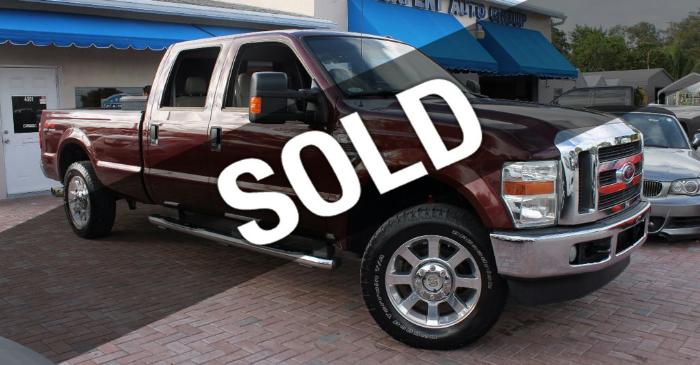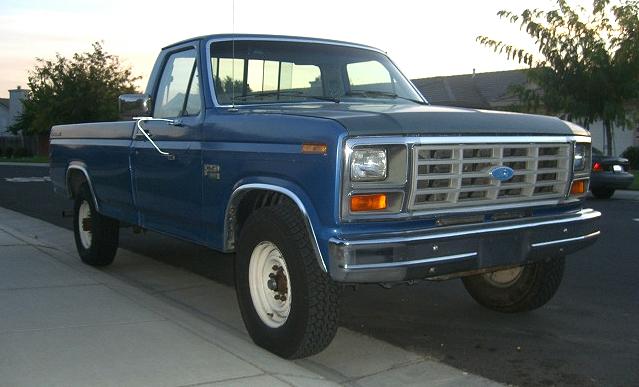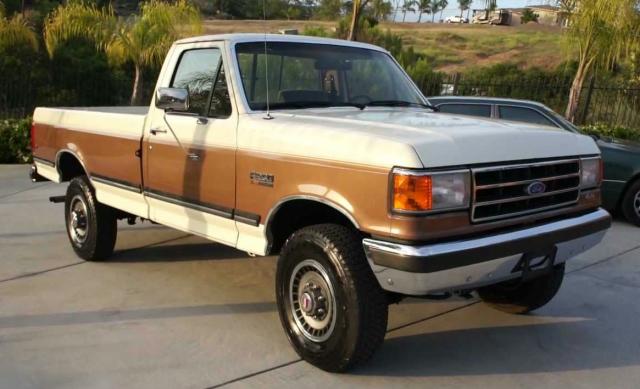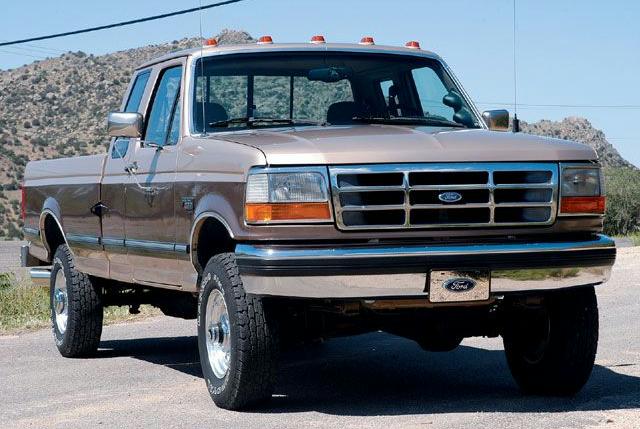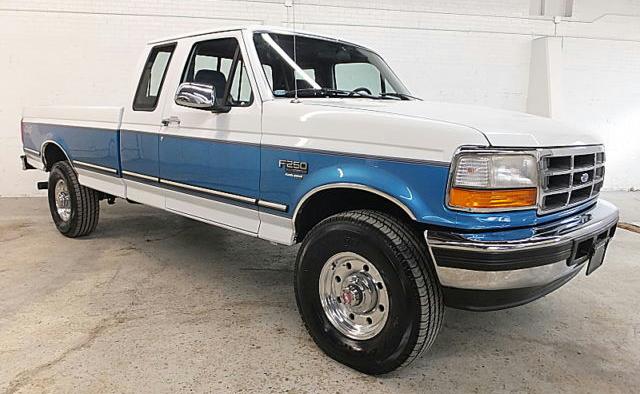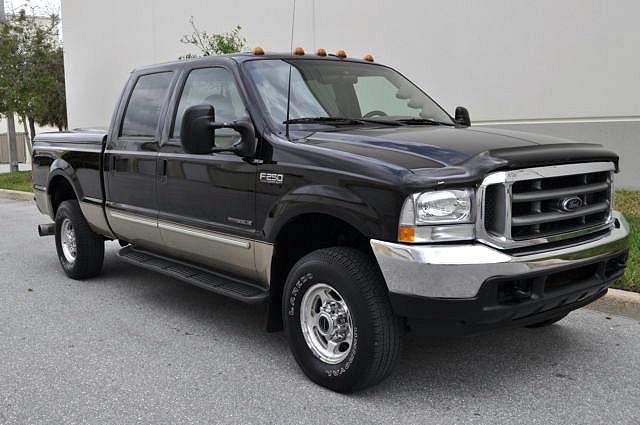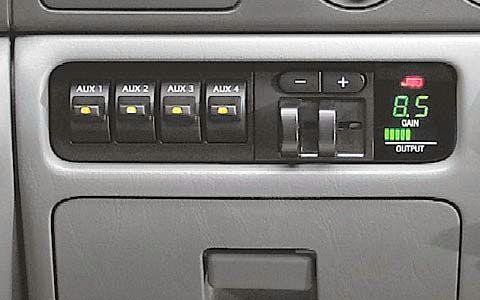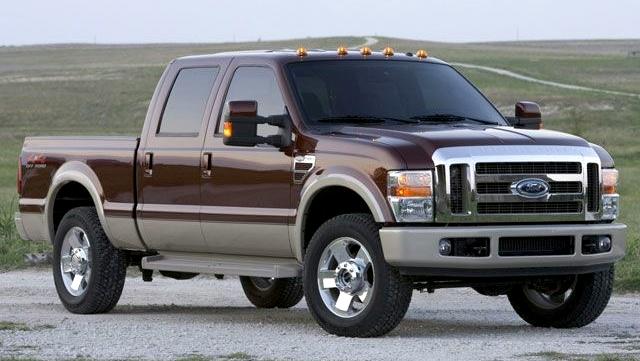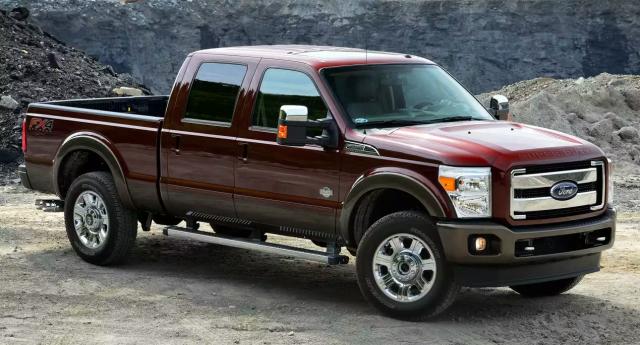Looking to buy a used Ford F-250/350 with a diesel? Here’s a break down of the different body styles, and the diesel motors that came in them.
Quick Overview:
The diesels from 1983-2010 were built by Navistar (formerly International Harvester).
In 2011, Ford offered the new 6.7L Power Stroke which was built by Ford. The 6.4L Power Stroke was the last of the Navistar motors.
The diesels prior to the Power Stroke are referred to as the 6.9 IDI and 7.3 IDI. You may hear someone mention a 7.3 IDI instead of a 7.3 Power Stroke. The IDI stands for InDirect Injection. The Power Stroke motors are direct injection. When the 7.3 Power Stroke came out, people would generally refer to the non-Power Stroke 7.3’s as the 7.3 IDI to help tell them apart.
Overview By Year:
- 1983-1986 – 6.9L IDI Navistar Diesel V8 – 170 hp
- 1988-1991 – 7.3L IDI Navistar Diesel V8 – 180 hp
- 1992-1996 – 7.3L IDI Navistar Turbo Diesel V8 – 190 hp/395 trq
- 1995-1996 – 7.3L IDI Navistar Power Stroke Turbo Diesel V8 – 210 hp/425 trq
- 1999-2003 – 7.3L Navistar Power Stroke turbo-Diesel V8 – 250 hp/500 trq
- 2003-2007 – 6.0L Navistar Power Stroke Turbo Diesel V-8 with HEUI injection system 325 hp/ 560-570 trq
- 2008-2010 – 6.4L Navistar Power Stroke V-8 with Siemens common-rail injection system 350 hp/650 trq
- 2011 – 2014 – 6.7L Ford Power Stroke Turbo Diesel V-8 – 400 hp / 800 trq
- 2015 – 2017 – 6.7L Ford Power Stroke Turbo Diesel V-8 – 440 hp / 860 trq
1983-1986 Ford F-250 & F-350
(1985 Ford F-250)
In 1983, Ford added diesel power to the F-Series through a partnership with International Harvester (later Navistar). The 6.9L, 420 C.I. IDI (InDirect Injection) V8 produced similar power output (170 hp) as the gasoline 351 Windsor V8, with the fuel economy of the 4.9L, 300 I6.
Not sure how many 1983-1986 Ford F-250 / F-350’s are left, but if you find one with the 6.9L Diesel, you might luck out and find one with a Banks Turbo Kit installed on it.
1983 Engine: 6.9L IDI Diesel – 170 horsepower at 3,300 rpm – 315 lb-ft torque at 1,400 rpm
1983 Transmission(S): C6 (three-speed) T-19 BorgWarner (four-speed)
1983 Engine Notes: 6.9L 420ci, naturally aspirated 20.7:1 compression
1984-1987 Engine: 6.9L IDI Diesel – 170 horsepower at 3,300 rpm – 338 lb-ft torque at 1,400 rpm
1984-1987 Transmission(S): C6/T-19 BorgWarner (four-speed)
1984-1987 Engine Notes: 6.9L compression increased to 21.5:1
1988-1991 Ford F-250 & F-350
(1991 Ford F-250)
In 1988, International Navistar increased the displacement of their 6.9-liter V8 to 7.3-liters. This was also the first year of a 5-speed manual overdrive transmission, which included the heavy-duty ZF5 in the F-250s and F-350s. The C6 three-speed automatic was replaced as the base automatic transmission with the E4OD, a four-speed electronically controlled automatic overdrive unit, though the C6 was still available as an option, in F-250s and F-350s, until 1997. Heavy-Duty models included F-250s and F-350s (along with F-Super Dutys) that were classified as incomplete vehicles only that were produced with no bed, but appeared as tow trucks, box trucks (notably U-Haul), flatbed trucks, dump trucks and other models. Although the F-250s, F-250 HDs (heavy duty), and F-350s were built as a Chassis cab models only from 1987 to 1997, owners can convert the models to pickup trucks. Don’t get these ‘Super Duty’s’ confused with the 1999 and newer Super Duty pickups.
These 7.3L IDI (InDirect Injection) engines were known to go through glow plugs.
Engine: 7.3 L International Harvester IDI Diesel V8, 180 hp at 3,300 rpm – 345 lb-ft torque at 1,400 rpm
Transmission(s): ZF5 5-speed, E4OD 4-speed automatic, C6 3-speed automatic
Transmission(s): C6 & T-19 (’88)E4OD & ZF five-speed (1989-1992)
Engine Notes: 7.3L 444 ci, naturally aspirated Increased 6.9L bore from 4.00 to 4.11
1993-1994 Ford F-250 & F-350
In 1993 and 1994, Ford turbocharged the 7.3L IDI (with an ATS turbo). The 7.3L IDI turbo (190 hp/395 ft lb) was only used with the automatic transmission. The 7.3L Power Stroke turbo was offered midway through 1994, but only with the 5-speed.
The non-turbo 7.3L IDI was still available in 1993-1994.
Starting 1n 1995, all Ford Diesels were the 7.3L Power Strokes.
Engine: 7.3L IDI (non-turbo) 185 horsepower at 3,300 rpm 360 lb-ft at 1,400 rpm
Engine: 7.3L IDI Turbo 190 horsepower at 3,300 388 lb-ft at 1,400 rpm
Transmission(s): E4OD/ZF five-speed
Engine Notes: Two options: 7.3L naturally aspirated or 7.3L turbo
1994.5-1997 Ford F-250 & F-350
(1996 Ford F-250)
Introduced in mid 1994, Ford’s 7.3L Power Stroke was a power improvement over the previous IDI 7.3L diesel. These trucks, and their diesel engines, are known for being rugged and reliable trucks. Likewise, the 7.3L can last well beyond 400,000 miles if well maintained. The 7.3L’s direct injection setup combined with its HEUI injection system, definitely makes it one of the more audible Ford diesels.
Rust issues due to a lack of factory undercoating protection, sporadic camshaft position sensor failure.
Engine: 7.3L Power Stroke V-8 with HEUI injection system 210 horsepower/425 ft.lbf torque
Transmission(s): E4OD 4-speed automatic, ZF-5 5-speed manual
Best Year(s): 1997 due to thicker engine block. The F-350 4×4 will have a Dana 60 solid front axle, where as the F-250 4×4 will have a Dana 50 or Dana 44HD.
Pros:
- Very reliable
- Simple, rugged truck design
- Respectable fuel economy (20-mpg empty isn’t out of line with 3.55 gears)
- 400,000 to 500,000-mile longevity with proper maintenance
- Large displacement makes the 7.3L less dependent on turbo boost than other engines
- Forged steel connecting rods on all engines
Cons:
- No factory intercooler
- Slouchy power without a programmer in the mix
- Mechanical lift pump delivered lower fuel supply pressure
- Dana 50 TTB proved problematic on 4×4 F-250 models (various wear points)
- Added horsepower and heavy towing can quickly kill the E4OD automatic
- Camshaft position sensor is the 7.3L’s one Achilles heel
1999-2003 Ford F-250 & F-350
(2000 Ford Super Duty)
Following the redesign of the 1997 Ford F-150, the Ford F-Series began a transition in its layout. In response to the changing demographics of pickup truck purchases during the 1980’s and 1990’s, Ford shifted the design of the F-150 separate from the larger F-250 and F-350. While still a full-size pickup under the skin, the F-150 adopted carlike aerodynamics and convenience features to expand its appeal among consumers.
To market a truck that appealed towards commercial buyers, fleet buyers, and users who tow, Ford sought to create a separate, dedicated heavy-duty truck platform (in place of using one chassis for all of its trucks). The new Super Duty would be distinguished from the F-150 by its unique body style, along with it’s own distinct chassis with heavier-duty chassis and suspension components to allow for higher payload and towing capacities. The result was a truck that set the industry standard for the modern heavy-duty diesel pickup. With more than 1.7 million 7.3L Power Strokes produced, replacement part availability remains high.
Rust-free, straight-bodied versions with the 7.3L Power Stroke carry a hefty premium, especially after the newer 6.0L Power Strokes developed a reputation for being unreliable.
Engine: 7.3L Power Stroke V-8 with HEUI injection system 250 horsepower/500 ft.lbf torque
Transmission(s): 4R100 4-speed automatic, ZF-6 6-speed manual
Best Year(s): ’99½ (late ‘99) to ’00 F-250 or F-350 due to these engines having forged steel connecting rods, the later style turbocharger (with 3-inch piping), and higher volume high-pressure oil pump
Pros:
- Very reliable
- Factory intercooler
- Great tow vehicles that are very stable with heavy loads behind them
- Electric lift pump for improved fuel supply pressure and easier serviceability
- Split shot injectors quieted down the 7.3L engine over ’94.5-’97 models
Cons:
- Slouchy power without a programmer in the mix
- Added horsepower and heavy towing can quickly kill the 4R100 automatic
- Powdered metal connecting rod engines (’01-‘03) are not ideal for pursuing big horsepower
- Camshaft position sensor is the 7.3L’s one Achilles heel
- As they continue to age, a new phenomenon of failed PCM’s is plaguing them
2003-2007 Ford F-250 & F-350
(2005 Ford Super Duty – updated headlights, grill and bumper)
While most diesel GM and Dodge trucks from 2003-2007 are desirable due to their lack of emissions-related components, a 6.0L powered Super Duty can typically be had for $10,000 less. However, by the time the engine’s head gasket, EGR, oil cooler, turbo, and injection system issues are addressed, that 10-grand saved at the time of purchase may have been needed for the repairs.
With that said, thanks to a variable geometry turbo, higher pressure HEUI injection system, and a well-matched 5R110 automatic, the 6.0L Power Stroke is light-years ahead of the 7.3L it replaced in terms of drivability and performance. You just have to know what you’re getting yourself into (financially) with this generation Super Duty.
It’s important to make note of a check engine light when looking at the 6.0L (and newer) Power Strokes. You never know what the previous owner has done to it, and what emissions related components they may have removed.
Engine: 6.0L Power Stroke V-8 with HEUI injection system 325 horsepower and 560 to 570 lb-ft torque
Transmission(s): 5R110 5-speed automatic, ZF-6 6-speed manual
Best Year(s): ’06-’07 later models, as some of (not all) mechanical engine issues were ironed out
Pros:
- 6.0L offers great power given its smaller displacement (325hp and 560 to 570 lb-ft)
- VGT turbo for instant throttle response
- 5R110 TorqShift automatics are very tough and reliable
- 2005+ models received coil spring front suspension and other chassis upgrades for improved towing and hauling capacity
- Optional auxiliary switches and Integrated trailer brake controller option starting in 2005
Cons:
- Engines can be highly unreliable
- Head gasket, EGR, and oil cooler failures are very common
- Injection system issues run rampant (high pressure oil leaks, failed injectors, FICM failure, etc.)
- Turbo “sticking” issues are typical
- Resale value is very low due to the engine’s known problems
- Fairly expensive to fix
(Starting in 2005, Ford added optional auxiliary switches as well as a built in brake controller)
2008-2010 Ford F-250 & F-350
(2008 Ford Super Duty)
If you’re looking to make big plug-and-play horsepower, look no further than the 6.4L Power Stroke. With a programmer and free-flowing exhaust the 2008-2010 trucks can produce 550 to 600 horsepower at the wheels.
However, as they begin to age, shops have determined that most of them won’t last hundreds of thousands of miles without requiring major repair(s). Failed injectors, high-pressure fuel pumps, and cracked pistons are all becoming more and more common before, near, or just past the 200,000-mile mark.
Engine: 6.4L Power Stroke V-8 with Siemens common-rail injection system 350 hp @ 3,000 RPM 650 lb-ft @ 2,000 RPM
Transmission(s): 5R110 5-speed automatic, ZF-6 6-speed manual
Best Year(s): Any year but with lower miles and detailed service records (lack of maintenance can wreck the common-rail system)
Pros:
- Very easy to add power
- Factory compound turbocharger system is great for response and top end power
- Common-rail injection means more horsepower, torque, and also a quieter engine
- Improved version of the 5R110 TorqShift automatic is even stronger than ’03-’07 models
- Integrated trailer brake controller option
Cons:
- Engines are extremely expensive to fix
- Rarely does the 6.4L make it past 200,000 miles without needing a major repair
- Poor fuel economy (12-15 mpg empty) with emissions equipment intact
- Emissions control devices add a failure point
- Injection system, cracked piston, and melted piston scenarios are all common with age
2011-2016 Ford F-250 & F-350
(2015 Ford Super Duty)
The 2011-2016 trucks represent the most capable Super Duty’s ever assembled. Their tremendous ability to lug gives them a low-end torque feel reminiscent of a Cummins, and the combination of a quick-spooling variable geometry turbocharger, standard exhaust brake, and integrated trailer brake controller makes for a very smooth and uneventful towing experience. The 6.7L Power Stroke is built in-house by Ford Motor Company and in conjunction with a Bosch common-rail injection system (and piezoelectric injectors) is the most powerful yet quietest Power Stroke ever produced.
Turbo failure is common on 2011-2014 trucks, and EGR problems can surface around the time the factory powertrain warranty ends, but other than that, the 6.7L has earned a reputation for stellar reliability…..so far.
Engine: 6.7L Power Stroke V-8 with Bosch common-rail injection system
2011 – 2014 pickup: 400 hp @ 2,800 rpm 800 lb-ft @ 1,600 rpm
2015 – current pickup: 440 hp @ 2,800 rpm 860 lb-ft @ 1,600 rpm
Transmission(s): 6R140 6-speed automatic
Best Year(s): 2015 or newer due to an updated turbocharger and 440hp, 860 lb-ft offered from the factory
Pros:
- 6.7L Power Stroke has proven reliable so far
- VGT turbo for instant response
- 400hp and 800 lb-ft (2011-2014), 440 hp and 860 lb-ft (2015+) available right out of the box
- Great tow rigs with gobs of low-end torque on tap throughout the rpm range
- 6R140 TorqShift automatics have proven tough and reliable to date
- Integrated exhaust brake
- Integrated trailer brake controller
Cons:
- 2011-2014 models are known for turbo failure (over-speeding of the turbo is common)
- Emissions system adds multiple failure points, but urea (diesel exhaust fluid) injection brings fuel economy back closer to where it was before the ’08-’10 trucks (14-18 mpg empty)
- EGR failures are common between the 70,000 to 90,000-mile mark

